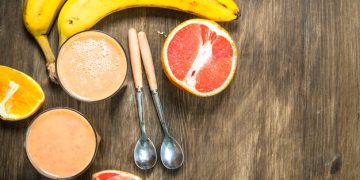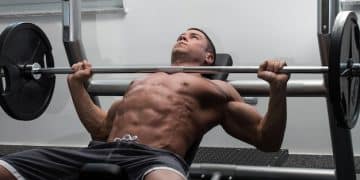Intermittent Fasting & Bodybuilding: 16/8 Nutrition Plan Guide

Achieving muscle growth while optimizing fat loss often involves strategic nutritional approaches like intermittent fasting and bodybuilding; the 16/8 method offers a structured eating window that can be effectively integrated with resistance training, providing a sample nutrition plan focused on nutrient timing and macronutrient distribution to support both performance and recovery goals.
In the relentless pursuit of peak physical condition, bodybuilders and fitness enthusiasts continually explore innovative strategies to optimize muscle growth, fat loss, and overall performance. Amidst a plethora of dietary approaches, intermittent fasting and bodybuilding, particularly the 16/8 method, has emerged as a topic of significant interest. This article delves into how to effectively integrate this popular eating pattern with rigorous training, providing a sample nutrition plan designed to support both your strength aspirations and body composition goals.
Understanding Intermittent Fasting and Its Appeal for Bodybuilders
Intermittent fasting (IF) is not a diet in the traditional sense, but rather an eating pattern that cycles between periods of eating and voluntary fasting. It doesn’t dictate which foods to eat, but rather concentrates on when to eat them. Among various IF protocols, the 16/8 method stands out for its simplicity and adaptability, making it particularly appealing for individuals seeking to manage their weight, improve metabolic health, and potentially enhance their bodybuilding efforts.
For bodybuilders, the allure of IF stems from its potential benefits beyond mere weight management. These include improved insulin sensitivity, which is crucial for nutrient partitioning and muscle anabolism, and enhanced fat burning, which can aid in achieving a leaner physique without excessive caloric restriction. The fixed eating window can also simplify meal preparation and planning, a significant advantage for those with demanding training schedules.
The 16/8 Method Explained
The 16/8 method involves fasting for 16 hours and restricting your eating to an 8-hour window each day. For example, if your eating window is from 1 PM to 9 PM, you would fast from 9 PM until 1 PM the next day. This routine naturally includes sleep as part of the fasting period, making it a relatively gentle introduction to intermittent fasting compared to more extreme protocols. The flexibility of scheduling the eating window allows individuals to tailor it to their lifestyle and training times.
During the fasting period, caloric intake is generally avoided, though water, black coffee, and unsweetened tea are permitted. The goal is to keep insulin levels low, encouraging the body to tap into stored fat for energy. When the eating window opens, the focus shifts to consuming nutrient-dense meals that support muscle repair, growth, and overall energy needs. Careful meal timing around workouts becomes paramount to maximize benefits.
The adaptability of the 16/8 protocol allows individuals to adjust their eating window to best suit their daily routine and training schedule. It provides a structured yet flexible framework that can be sustained long-term, unlike many restrictive diets. This sustainability is a key factor in achieving consistent progress in bodybuilding, where adherence to a plan is as important as the plan itself.
- Simplicity: Easy to follow with clear guidelines.
- Flexibility: Eating window can be adjusted to fit daily life.
- Metabolic Benefits: May improve insulin sensitivity and fat oxidation.
Ultimately, the successful integration of 16/8 intermittent fasting into a bodybuilding regimen hinges on careful planning and consistent execution. Understanding the fundamental principles of IF and how they interact with the physiological demands of intense training is the first step towards harnessing its potential for your physique goals.
Optimizing Macronutrient Intake for Muscle Growth and Fat Loss
Regardless of whether one practices intermittent fasting or not, the cornerstone of any successful bodybuilding nutrition plan remains the precise management of macronutrients: proteins, carbohydrates, and fats. For those engaging in intermittent fasting and bodybuilding, this precision becomes even more critical given the condensed eating window. Each macronutrient plays a distinct yet interconnected role in muscle protein synthesis, energy provision, and overall bodily functions essential for a physique athlete.
Protein is paramount for muscle repair and growth, especially after intense training sessions. Carbohydrates fuel workouts and restore muscle glycogen, while healthy fats support hormone production and nutrient absorption. The challenge with a 16/8 protocol is to ensure adequate intake of each macro within a limited timeframe, preventing deficiencies that could hinder progress or recovery.
Protein: The Building Block
For bodybuilders, protein intake is non-negotiable. It provides the amino acids necessary for muscle protein synthesis, preventing muscle breakdown, and aiding in recovery. When following a 16/8 intermittent fasting schedule, it’s crucial toFront-load your protein intake during your eating window. Aim for 0.8 to 1 gram of protein per pound of body weight to support muscle anabolism, distributed across your meals within the 8-hour period.
Sources should be varied and high-quality, including lean meats, poultry, fish, eggs, dairy, and plant-based alternatives like legumes and tofu. Consuming protein with each meal ensures a steady supply of amino acids throughout the eating window, optimizing muscle repair. Protein shakes can be a convenient way to meet daily targets, especially after workouts.
Carbohydrates: Fueling Performance and Recovery
Carbohydrates are the primary fuel source for high-intensity exercise, including weightlifting. They replenish muscle glycogen stores, which are depleted during training, and play a vital role in muscle recovery. The timing of carbohydrate intake is particularly important for IF bodybuilders. Consuming a significant portion of your daily carbs around your workout (pre and post) can maximize performance and facilitate glycogen repletion.
Complex carbohydrates such as oats, brown rice, whole-wheat bread, and sweet potatoes should form the bulk of your carb intake, providing sustained energy. Simple carbohydrates, like fruits, can be beneficial immediately post-workout to kickstart recovery. The quantity of carbs will depend on individual training intensity, body weight, and goals (e.g., bulking vs. cutting).
Fats: Essential for Health and Hormones
Dietary fats are often misunderstood but are indispensable for overall health, hormone production (especially testosterone, crucial for muscle growth), and nutrient absorption. They also provide a concentrated source of energy, which can be particularly useful in a fasted training state. Healthy fats should constitute around 20-30% of your total daily caloric intake.
Good sources include avocados, nuts, seeds, olive oil, and fatty fish like salmon. Incorporating these fats into your meals provides satiety, which can be beneficial in managing hunger during the fasting window, and supports overall physiological functions. Balancing unsaturated and saturated fats is key for optimal health and performance.

The strategic distribution of these macronutrients within the 8-hour eating window is what separates a successful 16/8 intermittent fasting approach for bodybuilding from one that might hinder progress. It requires meticulous planning and a deep understanding of your body’s specific needs, which can evolve based on training phases and goals.
Sample Nutrition Plan: 16/8 Method for Bodybuilding
Crafting a nutrition plan that effectively combines intermittent fasting and bodybuilding using the 16/8 method requires careful consideration of meal timing, macronutrient distribution, and overall caloric intake. This sample plan assumes an 8-hour eating window from 1 PM to 9 PM, which can be adjusted to fit your personal schedule. The focus is on nutrient density and strategic timing to support muscle protein synthesis and energy levels while navigating the fasting period.
This plan prioritizes a substantial meal post-workout to capitalize on the anabolic window and ensure adequate recovery. It also ensures that all essential macronutrients are consumed within the window, preventing any deficiencies that could impede progress. Individual caloric and macronutrient needs will vary based on body weight, activity level, and specific goals (e.g., muscle gain, fat loss).
Meal 1 (1:00 PM – Breaking the Fast, Post-Workout)
Assuming a morning workout, this meal is crucial for replenishing glycogen and initiating muscle repair. It should be rich in both protein and carbohydrates. A balanced combination ensures adequate energy for the remainder of the day and kickstarts the recovery process. This meal sets the tone for the entire eating window, providing a strong nutritional foundation.
- Protein: 6-8 oz (approx. 170-225g) chicken breast or lean beef.
- Carbohydrates: 1 cup cooked brown rice or quinoa, 1 large sweet potato.
- Fats: 1/4 avocado or a tablespoon of olive oil.
- Vegetables: Large serving of mixed green vegetables (e.g., broccoli, spinach).
- Example: Grilled chicken with roasted sweet potatoes, a side salad drizzled with olive oil, and a sprinkle of avocado.
Meal 2 (4:30 PM – Mid-Window Refuel)
This meal serves as a bridge, providing sustained energy and continued nutrient delivery between the first and last meals. It can be a slightly lighter meal, focusing on lean protein and complex carbohydrates to maintain satiety and support ongoing recovery. This ensures a steady flow of nutrients as the day progresses.
- Protein: 5-6 oz (approx. 140-170g) cod or turkey breast.
- Carbohydrates: 1 slice whole-wheat sourdough bread or 1/2 cup black beans.
- Fats: Small handful of almonds or walnuts.
- Fruit: 1 apple or a handful of berries.
- Example: Turkey and vegetable stir-fry with a small serving of whole-grain noodles.
Meal 3 (8:30 PM – Pre-Fasting Meal)
This final meal before the fast requires careful planning to provide sufficient nutrients for overnight recovery without causing digestive discomfort. It should emphasize slow-digesting proteins and complex carbohydrates to support muscle repair throughout the night. Including healthy fats can also aid satiety and provide sustained energy.
- Protein: 6-7 oz (approx. 170-200g) salmon or cottage cheese.
- Carbohydrates: 1 cup mixed berries with Greek yogurt or a small portion of oats.
- Fats: 1 tablespoon of flax seeds or chia seeds.
- Example: Baked salmon with steamed asparagus and a side of Greek yogurt with berries and seeds.
Adjusting portion sizes to meet your specific caloric and macronutrient goals is essential. Listening to your body’s hunger cues and energy levels will also help refine this sample plan. Remember, consistency and adherence are key to seeing results from any nutrition strategy rooted in intermittent fasting and bodybuilding.
Training Considerations While Intermittent Fasting
Integrating a rigorous bodybuilding training regimen with intermittent fasting and bodybuilding, specifically the 16/8 method, presents unique considerations. The timing of your workouts relative to your eating window and the intensity of your sessions can significantly impact performance, recovery, and adaptation. Strategic planning is crucial to maximize muscle growth and strength gains while leveraging the metabolic benefits of IF.
Training in a fasted state, typically towards the end of the fasting window, is a common practice among IF adherents. This can potentially enhance fat oxidation during exercise. However, for intense weight training, where performance is paramount, some find it beneficial to train closer to the start of their eating window, allowing for pre-workout nutrition and immediate post-workout fueling.
Timing Your Workouts
The optimal time to train while following the 16/8 method largely depends on individual preference and how your body responds. There are two primary approaches:
- Fasted Training (Late Morning/Early Afternoon): Training towards the end of your fasting window allows you to break your fast immediately after your workout. This approach may promote greater fat oxidation during exercise. It’s common for individuals to feel more alert and focused during fasted cardio or light resistance training. For heavy lifting, however, some might experience a dip in strength or endurance.
- Fed Training (Within Eating Window): Training a few hours into your eating window, after you’ve had at least one meal, ensures you have readily available glycogen stores for energy. This often allows for higher intensity and better performance during resistance training. Immediate post-workout nutrition is also easier to implement when you’re already in your eating window.
Experimenting with both approaches can help you determine which best supports your energy levels, strength, and recovery for bodybuilding. Some find a blend works best, with fasted cardio and fed resistance training.
Pre- and Post-Workout Nutrition
Even with a condensed eating window, pre- and post-workout nutrition remains vital for bodybuilders. If training fasted, consume essential amino acids (EAAs) or branched-chain amino acids (BCAAs) before and during your workout to mitigate muscle protein breakdown, though this is debated as truly necessity for those consuming sufficient protein over 24 hours. Immediately after training, especially if done fasted, prioritize fast-digesting protein and carbohydrates to kickstart recovery and muscle protein synthesis.
If training fed, a meal consisting of complex carbohydrates and lean protein 2-3 hours before your workout can provide sustained energy. Post-workout, a blend of fast-acting protein (e.g., whey) and carbohydrates (e.g., fruit, dextrose) is beneficial for rapid glycogen replenishment and muscle repair. This strategic nutrient timing within the 8-hour window is key for maximizing gains when combining intermittent fasting and bodybuilding.
Adjusting Training Intensity and Volume
inizially, some individuals might experience a slight dip in performance or energy when first starting 16/8 IF. It’s advisable to gradually adjust your training intensity or volume during the adaptation phase. Instead of immediately pushing for personal bests, focus on maintaining proper form and consistent effort. As your body adapts to the new eating pattern, energy levels and strength typically return to normal or even improve.
Monitoring your recovery is also crucial. If you notice prolonged muscle soreness, fatigue, or a significant drop in strength, it may indicate a need to adjust your training schedule, increase your caloric intake within the eating window, or reconsider the timing of your workouts relative to your fast. Listening to your body is paramount for sustainable progress.
Effectively managing training alongside intermittent fasting requires a personalized approach. What works for one person may not work for another. Consistent tracking of performance, recovery, and body composition changes will provide valuable insights into optimizing your combined training and nutrition strategy.
Potential Benefits and Challenges of Combining IF and Bodybuilding
The growing interest in integrating intermittent fasting and bodybuilding stems from a perception of numerous potential benefits, ranging from improved metabolic health to enhanced body composition. However, like any dietary approach, it also presents distinct challenges that require careful navigation, especially for those pursuing significant muscle mass and strength.
A balanced perspective is essential to determine if this approach aligns with individual goals and physiological responses. While some bodybuilders thrive on IF, others may find it hinders their progress or is simply unsustainable given their specific training demands.
Potential Benefits
- Improved Insulin Sensitivity: Fasting can enhance the body’s sensitivity to insulin, which means cells become more efficient at absorbing glucose from the bloodstream. For bodybuilders, better insulin sensitivity can lead to more efficient nutrient partitioning, directing carbohydrates and amino acids primarily to muscle cells rather than fat cells.
- Enhanced Fat Loss: During the fasted state, the body tends to utilize stored fat for energy. This can accelerate fat loss, particularly for those aiming to achieve a leaner physique or during cutting phases. The fixed eating window can also naturally lead to a caloric deficit for some individuals.
- Simplification of Nutrition: Consolidating meals into an 8-hour window can simplify meal prep and planning, reducing the time spent thinking about food. This can be a practical advantage for busy individuals who want to maintain a structured diet without constant preparation.
- Potential for Autophagy: While evidence in humans is still evolving, some animal studies suggest that fasting can trigger autophagy, a cellular cleansing process that removes damaged cells and regenerates new ones. This process could hypothetically contribute to improved cellular health and longevity, relevant for long-term health in athletes.
Challenges and Considerations
- Maintaining Muscle Mass: A primary concern for bodybuilders is potential muscle loss during fasting. While studies suggest that IF can be muscle-sparing when protein intake is adequate, a consistently low caloric intake or insufficient protein within the eating window could pose a risk, especially during intense training cycles.
- Nutrient Timing and Performance: For high-intensity weightlifting, having readily available glucose from carbohydrates is crucial for performance. Training in a completely fasted state might lead to reduced strength, endurance, or overall workout quality for some individuals. Careful timing of meals around workouts is therefore critical.
- Hunger and Adherence: Adapting to prolonged fasting periods can be challenging initially. Hunger pangs, irritability, and decreased focus are common side effects during the adaptation phase. Long-term adherence depends on an individual’s ability to manage these sensations and integrate the eating pattern seamlessly into their lifestyle.
- Meeting Caloric Needs: For bodybuilders aiming to gain significant muscle mass (bulking phase), consuming a sufficient number of calories within an 8-hour window can be difficult. High caloric and macronutrient targets might require very large meals, which can be uncomfortable or lead to digestive issues for some.

Careful monitoring of body composition, strength, and energy levels is paramount when implementing 16/8 intermittent fasting in a bodybuilding context. Adjustments to macro intake, meal timing, and training intensity may be necessary to overcome challenges and maximize the benefits. What works well for one individual might not be optimal for another, underscoring the importance of personalization.
Hydration and Supplementation Strategies
Beyond caloric and macronutrient intake, proper hydration and strategic supplementation are often overlooked yet critical components of any successful bodybuilding nutrition plan, especially when incorporating intermittent fasting and bodybuilding. During fasting periods, it’s easy to forget to drink enough water, and certain supplements can help bridge nutritional gaps or enhance performance without breaking the fast.
Maintaining optimal cellular function and aiding recovery relies heavily on consistent fluid intake. Likewise, certain supplements can provide a competitive edge, or simply ensure the body receives all necessary micronutrients that might be challenging to obtain solely through an 8-hour feeding window.
Staying Hydrated
Hydration is absolutely fundamental for performance, recovery, and overall health. During the fasting window, it’s crucial to consume adequate fluids. Water, black coffee, and unsweetened tea are permissible and can help manage hunger and maintain fluid balance. Dehydration can impair physical performance, reduce cognitive function, and lead to fatigue, all of which are detrimental to bodybuilding progress.
- Water: Aim for at least 3-4 liters of water daily, spread throughout both fasting and eating windows. Electrolyte-rich water can be beneficial, especially if sweating profusely during workouts.
- Black Coffee/Tea: These can be consumed in moderation during the fasting period. They offer mild stimulant effects and can assist with appetite suppression. Avoiding excessive amounts is recommended to prevent jitters or sleep disturbances.
- Electrolytes: Consider adding electrolyte supplements to your water, especially if you train in a fasted state or in hot conditions. Sodium, potassium, and magnesium are vital for muscle function and nerve impulses.
Key Supplements for IF Bodybuilders
While a whole-food diet should form the foundation, certain supplements can be highly beneficial for individuals combining intermittent fasting and bodybuilding. These are typically consumed during the eating window, but some, like BCAAs, might be considered during the fasted state depending on personal preference and training goals.
- Whey Protein: A fast-digesting protein source, ideal for post-workout recovery or to quickly meet protein targets within the eating window. It aids in muscle protein synthesis.
- Creatine Monohydrate: One of the most researched and effective supplements for increasing strength, power, and muscle mass. It does not break a fast and can be taken at any time.
- Branched-Chain Amino Acids (BCAAs): While controversial for “fast-breaking,” many bodybuilders use BCAAs (leucine, isoleucine, valine) during fasted training to reduce muscle breakdown. However, if sufficient protein is consumed daily, their necessity is debatable.
- Pre-Workout: If training in a fed state, a pre-workout supplement can enhance energy, focus, and blood flow for improved performance. Choose formulas without excessive calories.
- Multivitamin/Mineral: Ensures you’re not missing any vital micronutrients that might be harder to obtain with a condensed eating window.
- Omega-3s: Essential fatty acids found in fish oil, known for their anti-inflammatory properties, which can aid in recovery and overall joint health.
It’s important to consult with a healthcare professional or a registered dietitian before starting any new supplementation regimen, especially if you have underlying health conditions. Supplements should complement, not replace, a well-structured and nutrient-dense diet.
Adapting the Plan to Different Bodybuilding Phases
The beauty of the 16/8 intermittent fasting method for bodybuilding lies in its adaptability. While the core principle of a 16-hour fast and 8-hour eating window remains constant, the nutritional content within that window must fluidly adjust to different bodybuilding phases: bulking, cutting, and maintenance. Each phase has unique caloric and macronutrient demands, and a static plan will not yield optimal results for all stages.
Successful long-term progress in muscle building and fat loss with intermittent fasting and bodybuilding hinges on being able to dynamically alter the diet to meet these evolving physiological requirements. It requires a keen understanding of caloric surplus or deficit and nuanced adjustments to macronutrient ratios depending on the objective.
Bulking Phase (Muscle Gain)
During a bulking phase, the primary goal is muscle hypertrophy, which necessitates a caloric surplus. When following 16/8 IF, this means consuming a higher total number of calories within the 8-hour eating window. This can be challenging for some, as it requires larger, more nutrient-dense meals.
- Caloric Intake: Increase calories by 300-500 above maintenance.
- Macronutrients:
- Protein: Maintain high protein intake (1g/lb body weight) to support muscle synthesis.
- Carbohydrates: Significantly increase complex carbohydrate intake to fuel intense workouts and replenish glycogen. Focus on oats, rice, potatoes, and whole grains.
- Fats: Slightly increase healthy fat intake to bolster total calories without excessive volume, using sources like nuts, seeds, avocados, and olive oil.
- Meal Density: Focus on calorically dense, yet wholesome, foods. Liquid calories, such as smoothies with protein powder, oats, and nut butters, can aid in reaching high caloric targets without feeling overly full.
Cutting Phase (Fat Loss)
The cutting phase aims to reduce body fat while preserving as much muscle mass as possible. This requires a caloric deficit. Intermittent fasting can be particularly effective here, as the restricted eating window can naturally help manage overall caloric intake and potentially enhance fat burning.
- Caloric Intake: Create a deficit of 300-500 calories below maintenance.
- Macronutrients:
- Protein: Maintain or slightly increase protein intake (1g-1.2g/lb body weight) to prevent muscle breakdown during a caloric deficit.
- Carbohydrates: Reduce carbohydrate intake, focusing on fibrous vegetables and smaller portions of complex carbs, typically consumed around workouts.
- Fats: Keep healthy fat intake moderate (around 20-25% of total calories) to support hormone function and satiety.
- Food Choices: Prioritize lean proteins, plenty of non-starchy vegetables, and smaller portions of whole grains. Foods high in fiber can help with satiety during the cutting phase.
Maintenance Phase
The maintenance phase is about sustaining current body composition, often between bulking and cutting cycles. Calories are consumed at a level that supports energy expenditure without significant weight gain or loss. This phase allows for more flexibility and can be a good time to fine-tune your understanding of your body’s energy needs.
- Caloric Intake: Match maintenance calories (caloric expenditure).
- Macronutrients: Maintain a balanced ratio that supports performance and recovery while sustaining body composition. Protein remains high, carbohydrates are adjusted to fuel activity, and fats provide essential nutrients.
Regularly assessing your body’s response—how you feel, your strength levels, and changes in body composition—is paramount. Tools like scales, measuring tape, and progress photos can help you make informed decisions when adapting your intermittent fasting and bodybuilding nutrition plan across different phases. Consistency in adjustments is key to achieving desired outcomes.
| Key Point | Brief Description |
|---|---|
| ⏰ 16/8 Method | Fasting for 16 hours, eating across an 8-hour window daily. |
| 💪 Macronutrient Focus | Prioritize protein (0.8-1g/lb), strategic carbs, and healthy fats. |
| 🏋️ Training Timing | Train fasted or fed, adjusting pre/post-workout nutrition accordingly. |
| 🥗 Adaptation | Adjust calories and macros for bulking, cutting, or maintenance phases. |
Frequently Asked Questions
▼
Yes, many individuals successfully build muscle while practicing intermittent fasting. The key is to ensure adequate caloric intake and sufficient protein consumption within your eating window to support muscle protein synthesis. Nutrient timing around workouts is crucial to maximize recovery and growth.
▼
Focus on nutrient-dense, whole foods. Prioritize lean proteins (chicken, fish, beef, eggs), complex carbohydrates (oats, brown rice, sweet potatoes), and healthy fats (avocado, nuts, olive oil). Ensure your meals meet your daily caloric and macronutrient targets for your bodybuilding goals.
▼
Not necessarily. Research suggests that when protein intake is maintained at sufficient levels, and resistance training is consistent, muscle loss is minimal or nonexistent. The body adapts by becoming more efficient at using fat for fuel, sparing muscle tissue during the fasting period.
▼
Both approaches have proponents. Training fasted might enhance fat oxidation for some, while training fed typically allows for higher intensity and better performance, as glycogen stores are readily available. Experiment to see which method optimizes your energy levels and workout quality.
▼
Results vary based on individual consistency, genetics, training intensity, and overall adherence to the nutrition plan. Typically, body composition changes can be noticeable within a few weeks to months, especially improved leanness and energy levels as your body adapts to the new eating pattern.
Conclusion
Integrating 16/8 intermittent fasting and bodybuilding is a viable and increasingly popular strategy for many fitness enthusiasts seeking to optimize muscle gains and fat loss. By strategically timing your meals and meticulously managing your macronutrient intake within the condensed eating window, it’s possible to support rigorous training, enhance recovery, and achieve significant body composition improvements. While challenges like initial adaptation and ensuring sufficient caloric intake exist, a personalized approach to meal planning, workout timing, and supplementation can mitigate these hurdles. As with any significant dietary change, consistency, patience, and a willingness to adapt are paramount to harnessing the full potential of this combined approach for your long-term bodybuilding success.





